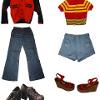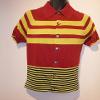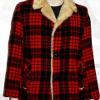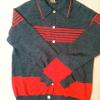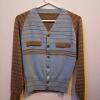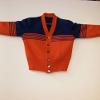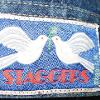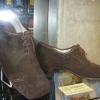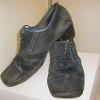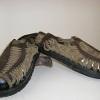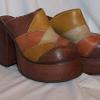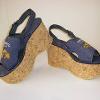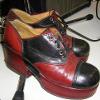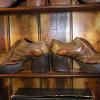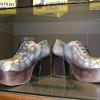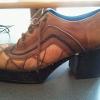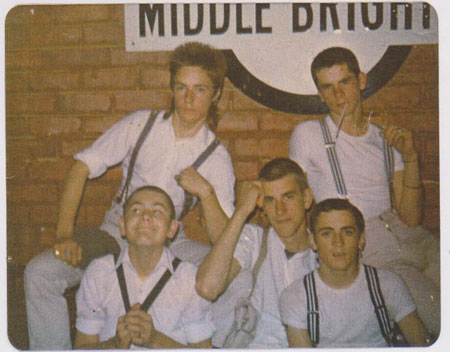Before Punks there were Sharpies!
The roots of the sharpie subculture lay in the influx of European immigrants in Victoria in the early 1960s. First off there were Mods and Rockers, two distinctive 1960s subcultures that were imported from the UK into Australia with the influx of the 'Ten Pound Pom' movement, that had reached its peak by 1969. While a lot of these British immigrants landed in Adelaide, many of the youth would end up quitting Adelaide for Melbourne, where they would become a key influence on the birth of the sharpie movement.
By the end of 1964 in Melbourne the rocker look was in decline and a new subculture was about to emerge from its ashes, ready to distinguish themselves from the look of their predecessors with a neater and more streamlined look.
The term 'sharpie' originated from the fashion; it was all about the clothes and looking 'sharp', and 'flash'. The first wave of sharpies from 1964 - 1970 were strongly influenced by the fashion of certain Italian migrants. The kids were all from working class families so the demeanor was tough, hair was short back and sides, usually parted and cut every two weeks, and clothing was custom made by European tailors, thus allowing for a blend of neo-thirties suave combined with a contemporary larrikin attitude.
Trousers, shirts and suits were made to order, partly because the sharp style could not be bought off the rack and partly for the thrill of one-upmanship.
An up-to-date wardrobe separated the aces from the offal. At first slightly flared trousers were the go but they were soon succeeded by 'flags', 22-inch bottoms, usually pinstripe, herring bone or Prince of Wales check in various hues of brown or grey. Someone had even devised a cigarette pocket halfway down the side of the leg with a V-shaped button-down flap.
Ban-lon/Crest-knit tops were short sleeved tennis shirts in the Lacoste/Ralp Lauren style. They generally had three buttons down the front and came in colours such as maroon, cream and green with contrasting stripes and piping. V-neck jumpers and cable-knit cardigans in maroon, cream, green and blue were often worn with a matching crest-knit or button-down plain or checked shirt.
Everybody had a trench coat; single breasted white was popular with no belt, while woolen overcoats were equally as popular in checked brown or charcoal grey. Porkpie hats were also popular in chocolate brown or hounds-tooth.
In 1964 'points' were the shoes of choice; pointy toed, suede or two-tone, slip-on or lace-up, sometimes flat-soled but usually with a Cuban heel. Not long after, the points on the shoes turned into a chisel toed look. Again, the basic design was flat soled or Cuban heeled. They would come with a brogue or basked weave pattern in blue suede, oxblood, two-tone brown and white or black and white. You could also get them made in patent leather or alligator skin if you wanted to be extra flashy.
European tailors and shoemakers such as Morris the Tailor, Dobbs, Kosmanos, Mediterranean, Acropolis, Batsanis and Venus were the places that sharpies frequented to go to get their clothes and shoes bespoke made. Levi's and Lee jeans also hit Melbourne around this time and made a big splash with the sharps and cost around 5 pounds a pair, which was usually a week's wages at that time.
"I became a Sharp myself at the end of what I call 'phase one' of the Sharpie reign. I got a pair of flags made by 'Morris the Tailor' in Camberwell, a grey venito v-neck jumper, a pair of chisels from Kosmanos in Collingwood, a navy-blue trench coat, and of course a Sharpie girl! It was an original Melbourne youth culture, and I was proud to be part of it. Later came the staggers jeans, stripped cardigans, hair tails, etc. But for me, I was glad to be involved and have witnessed the first phase of Sharp – 1967 to 1969, a period which not many people are aware of!"(Chris O'Halloran - Skins'n'Sharps)
Female sharpies were known as 'Brushes' who shunned the prevailing trends in women's fashion and instead favoured a crisp classic simplicity. Sharpie girls wore short-sleeved, round-necked dresses in a sort of woolen material, knee-length pleated skirts in shades of pink and blue for summer and darker colours for winter. Hair was short, varying in length from a Mia Farrow to a Cilla Black cut. Twin sets were popular as were pearl earrings and necklaces. Brushes also wore trench coats, overcoats, sandals and handmade shoes with flat heels.
Dances were also a big part of the sharpies social fabric, and this was where sharpies had the opportunity to wear their best threads, usually a dark coloured suit with a pinstripe, herringbone tonik flavour, complete with cufflinks and a tie pin for added swank.
In the mid - late 1960s Melbourne was buzzing and there were clubs and dancehalls everywhere. These included The White Elephant at Broadmeadows Town Hall, The Circle Ballroom in Preston, Impulse, Opus at Ormond Hall, and in the city there was Tenth Avenue, The Bowl, Berties, Sebastians, The Thumpin' Tum and The Catcher/Traffik.
Sharpies loved to dance, and they liked American soul and British beat sounds, the kind of music that led to crowded dance floors. Bands such as The Easybeats, Max Merritt and the Meteors, Billy Thorpe and the Aztecs, Purple Hearts, The Loved Ones, The Twilights, Normie Rowe, Axiom, Chelsea Set, Wild Cherries and Ronnie Burns were doing the circuit at that time and were all liked by the sharpie crowd.
“When the purple hearts first came down to Melbourne in 1967, we were a long-haired blues band. We started playing at the circle ballroom in Preston and i started noticing these strange people. I’d never seen anything like them and their distinct style! They had short hair and wore baggy trousers and cardigans; the girls wore knee-length pleated skirts, twin sets and pearls.” (Lobby lLoyde)
Every youth subculture creates its own dances and sharpies came up with two - 'The Break' or 'The Sharpie Shuffle' and 'The Sharpie Rock.' The Rock was a bit of a throwback to the rock'n'roll dancing of the fifties, while the Break was a kind of line dance where everyone was shoulder to shoulder, all dancing in unison.
There was a hierarchy in the sharpie world, with the scene's killer elite known as 'Top Fellas', while the lowest of the low was called a 'Chat' There was also the 'Older Fellas', a 'Gunny' a 'Knockabout' and an 'Apprentice'. All of these slang terms had different meanings and were used to describe someone's clout in the subculture.
Violence was also a major part of the sharpie subculture, with fights taking place between sharps, mods, rockers and surfers, but there were also sharp vs sharp battles. The police did not love the sharpies at all and would often lay in wait for them to fine them and beat them up.
For many years Australia had laws that required pubs to be closed by 6pm on weekdays and prohibited them from opening on Sundays. During this time the sly grogs (pubs and private houses where booze flowed at all hours) thrived. Sharpies were deep drinkers and were often too young to be served at pubs, so the sly grogs were a Godsend.
While the 1960s sharpie subculture was born in Melbourne's inner-city working-class suburbs such as Richmond, Fitzroy, Carlton, Collingwood and Brunswick, where Greek, Italian, Yugoslav and English immigrants all lived side by side, by the early 1970s, the sharpie movement started to spread to the outer suburbs of Melbourne.
The Second Wave of Sharpies:
From 1970-1980, the second wave of sharpies, sometimes referred to as 'skinheads' by the media, were following hard, tough rock’n’roll bands like Lobby Loyde and the Coloured Balls, Buster Brown, Rose Tattoo, The Angels, Skyhooks and ACDC.
Sharpies were now often congregating in large numbers, regularly attending live band concerts at town hall and high school dances as well as early discos. But due to their sheer numbers, sharpies were often perceived as being untouchable by the police and were often associated with excessive violence, regularly taking part in fights.
During this time the sharpie fashion had also changed slightly, with a leaner and more aggressive look that was marked by the influence of the British Skinhead subculture. Trilbies and trench coats were gone, hair was short on top and longer at the back (the precursor to the mullet), but the most significant addition made to the sharpie wardrobe was the Conti cardigan, or the 'Connie' as it was more commonly called.
The Connie soon became an essential part of the sharpie wardrobe. Some were round-necked, some V-necked and others had a Crestknit style collar. There was a small belt buttoned at the lower back, and they had pocket flaps, 5 buttons and stripes of varying widths and colours. Initially they were worn as a slim-fit – and later became tighter and tighter until the sleeves just covered the forearms, and it was as short as a midriff top.
The Connie was made in Thornbury by a Greek man named Mr. Conti, while another business called Sam's Knitwear in Coburg was also bringing out similar designs and doing a likewise roaring trade. The only design difference was that Sam’s had checks in the knit, while a Conti had stripes.
In the early 1970s a first-year apprentice earned sixteen dollars per week, and by the time they were on a full-time wage they earned thirty-six dollars per week. A Conti cardigan cost thirty dollars and came with a two week wait. However, customised dress codes brought prestige, and so there was a huge amount of time, money and pride invested in dressing up. Pretty soon kids started bringing in their own designs, sparing no expense to wow their mates with new patterns and colour combinations.
"I had about twenty Connies custom made over the years. I always had them dry cleaned and folded them like they were in the shop – the right way. You could get any style you wanted. A mate of mine had one with six belts running down the middle of his back. If someone tried on a cardigan from off the shelf Mr. Conti would always click his fingers and say, "Justa right for you" no matter if it was too big or whatever, that was his saying” (Cliff - Top Fellas)
Some sharps made their own t-shirts, using iron-on letters with the name of their gang on them – 'Blackburn Sharps', 'Westside Sharps' or music heroes 'Bowie' or 'Lobby'. Flags were replaced by Staggers jeans. Staggers were manufactured by Joseph Saba – very flared, very tight. There were also pinstripe and plain 'baggies' which were worn by both boys and girls and were high-waisted and very flared, so that they'd cover the whole of the shoe.
By 1973, braces and flat caps were worn; along with Miller shirts with metallic thread; Blueys – or lumber jackets with sheepskin lining and platform shoes. By the mid 70s 'treads' were also worn by Sharpies – these were woven open toed suede shoes with tyres for soles.
Brushes wore tight Connys and pastel coloured ‘Elti’ cardigans were worn with strap-on school shoes and later wedges with a 6-inch sole. High waisted flared leg pants, which would normally cover their platform or clogs shoes, as well as a pinafore or mini skirt in denim were also common wear. Halter neck tops, twin sets, pearl necklaces, striped socks, and satin pencil skirts were also part of the Sharpette's look.
Hair varied from short with fringe tails, and sometimes triggers, to a 'Bowie cut'. It was acceptable for a girl to keep her hair long but look sharp in every other respect. Makeup was plastered on, particularly around the eyes, and eyebrows were plucked pencil thin. Lipstick was pale, and nail polish was black, silver or iridescent greens and blues.
"Elti knitwear was a small shop in Bayswater. I can't remember what they had on their racks, but you could go in and buy made to order cardigans and jumpers. The cardigans were often striped and sometimes had patterns through them, and would have little animal shaped buttons, like what you see on old fashioned babies' clothes today. They also made jumpers and we would order a plain jumper, usually with a round neck. Our favorite design was black, with a silver spider, or a silver rose." (Julie Mac)
Tattoos were also a part of the look – and at fifteen or sixteen you could get tattooed by Dicky Reynolds, Alfie Mingus or Danny Robinson. The next group of Sharps had a meaner, more aggressive look. The shorter tighter fitting clothing made the body look bigger, an earring in the left ear was also permissible.
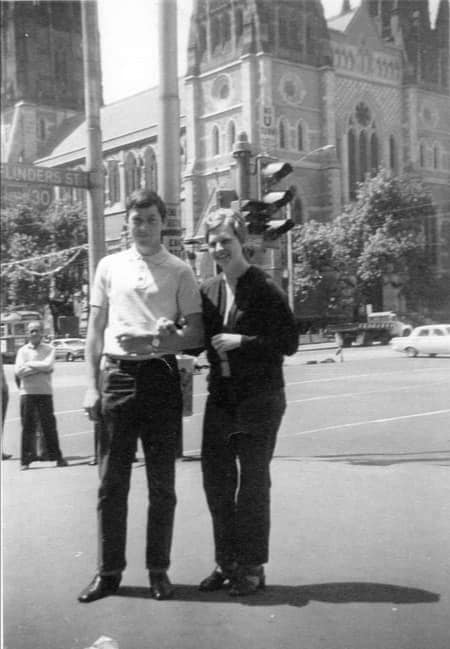
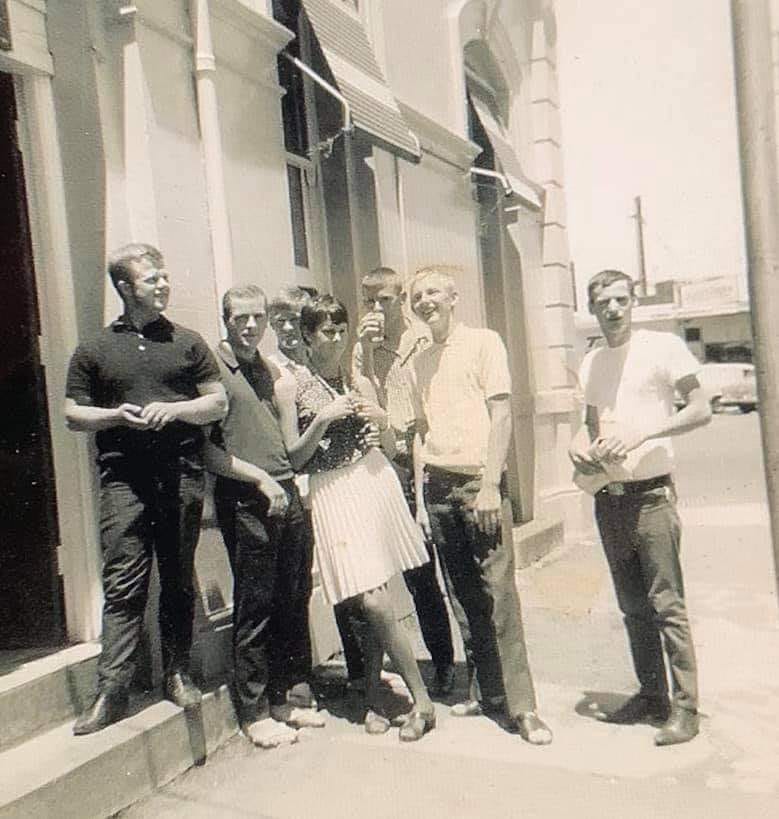
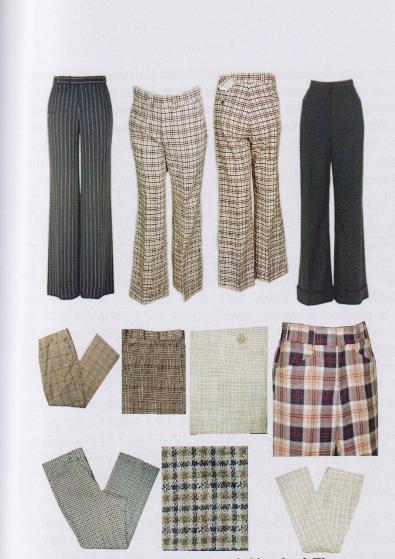
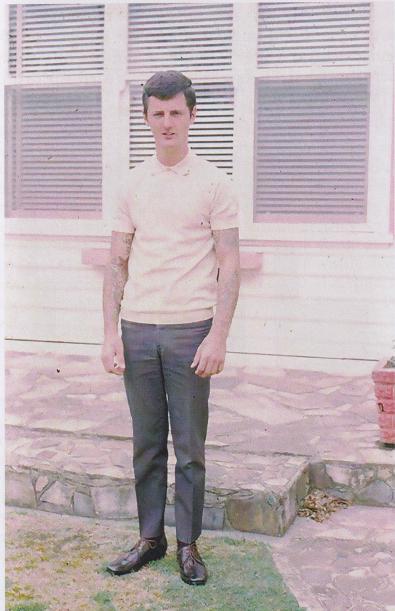
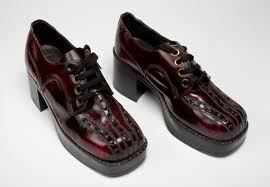
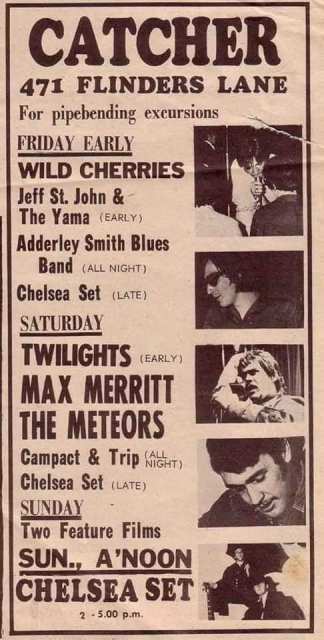
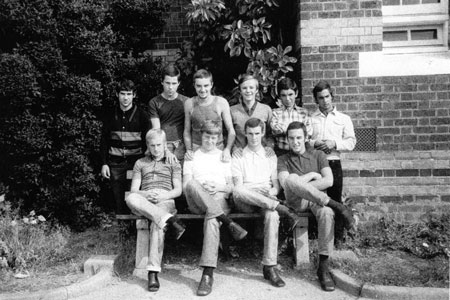
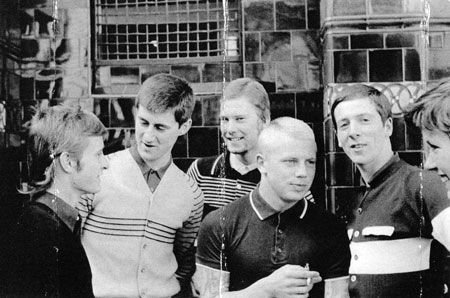
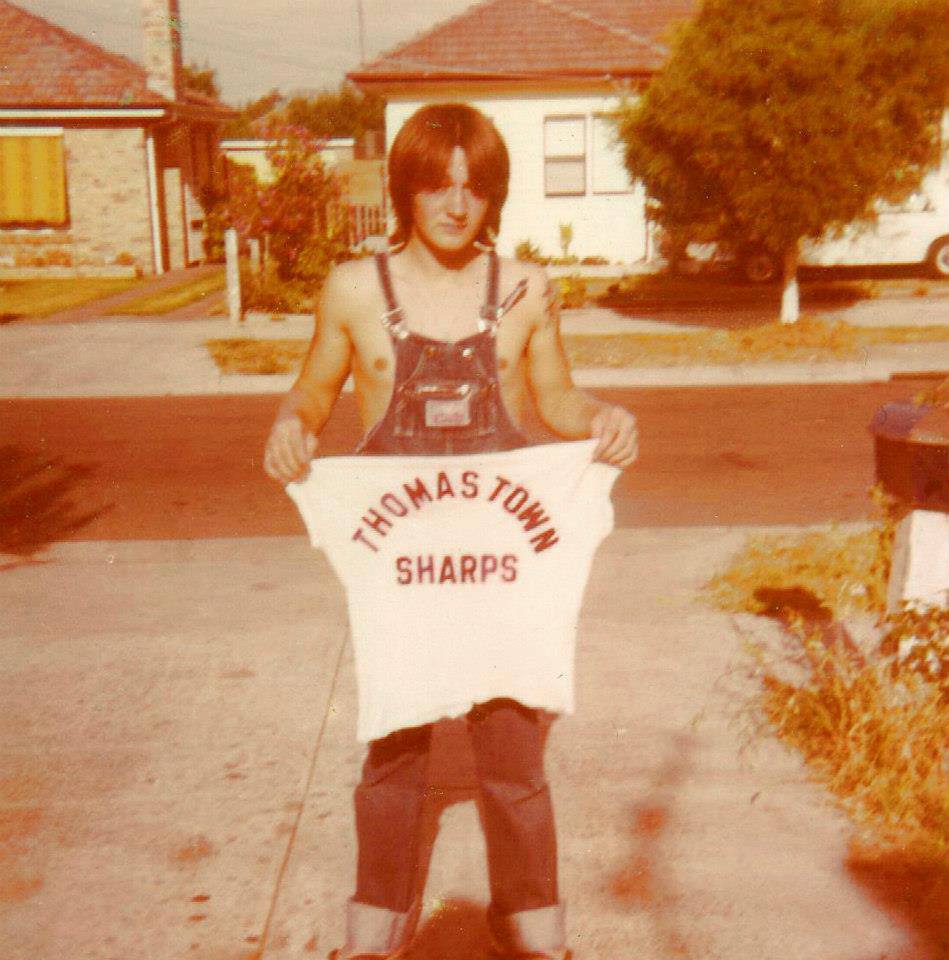
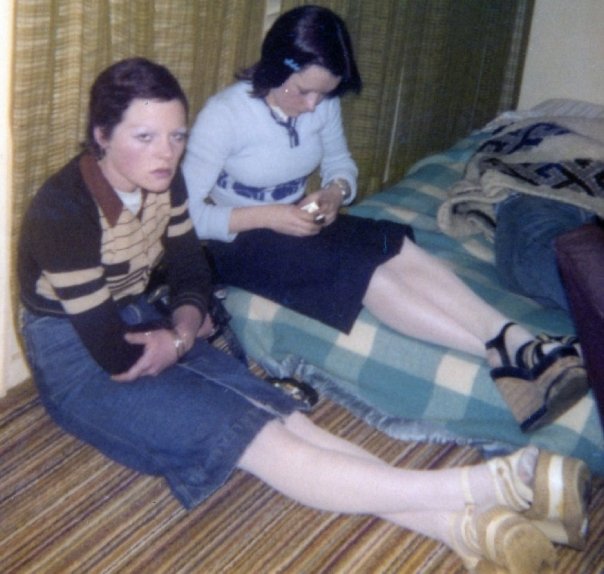
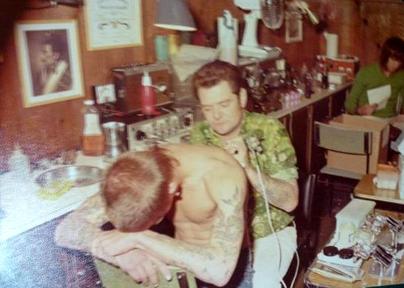
The birth of the glam culture in the early 1970s led to many sharpies taking a keen interest in bands like Slade, Suzie Quatro, David Bowie, T-Rex, Gary Glitter, Skyhooks and Hush. And it wasn't long before some of the sharpie boys, with their spiked hair and Ziggy Stardust features, were soon being given nicknames like 'Chane Bowie', 'John Bowie', 'Flipper Bowie' and 'Peter Bowie'.
On some occasions these Bowie boys would turn up to concerts or clubs wearing red, white and blue striped eye makeup as well as eyeliner and blue or black nail polish.
By 1977, punk had emerged as the new youth cult with its own fashion code and set of ideologies. But this nihilistic subculture, with its emphasis on breaking with the past, was soon having a dividing effect on the Sharpie world, with some sharpies identifying with the punk scene and integrating themselves into it, while others remained very hostile towards it.
"The Crystal Ballroom opened in 1979 and quickly became the focal point of Melbourne's Punk/New Wave scene. Located on Fitzroy Street, St Kilda, the Ballroom was just down the road from popular sharpie nightspots like Mickey's, Bananas and Kingston Rock. It wasn't long before Sharpies started turning up at the Ballroom, some curious about the new music, others with more malevolent intentions...
There were essentially three sharpie responses to punk: Some remained totally antagonistic to it, roughing up any punks unlucky enough to cross their path. Others dived in boot 'n' all, dropping the sharp image and throwing their lot in with the Ballroom crowd. A greater hedged their bets. They still wore their Connys and ran in mobs, but they'd sometimes hang around the punk clubs and got into a bit of the punk music and fashion."
But thanks to La Femme, a punk band consisting of former sharps, including frontman Chane Chane, many ex-sharpies successfully crossed over into this new genre of music, fashion and politics. However, by the second half of the seventies, after years of bad press and bad behaviour, being a sharpie was becoming hazardous.
Coupled with general mistrust and violence between different gangs, by 1979 the sharpie movement ended, splintering up into nightclubs with discos, pubs with punk bands or pure Aussie 'pub rock'.
“I started out as a sharpie from a gang in the northern suburbs called the Oak Park Boot Boys. We used to dress up in all whites and go out at midnight. I first heard about punk from this skinhead who was hanging around us from England. He came over to my place with this record by the Sex Pistols - 'Anarchy in the UK '- and we thought it was fantastic, so we started hanging around with the sharpies dressed as punks. It was a natural progression of youth culture, from one thing to another. When we first heard punk music, we all looked at each other and thought "We could do this!"
We understood what they were talking about, and we understood that the music wasn’t about being polished, that it was an alternative way of doing stuff. Then together with a couple of guys from my gang who started Teenage Radio Stars, we formed La Femme.
It was like being in a gang but instead of violence we were hitting people with our music. It was the same modus operandi. We used to go to gigs like they were fights and belt people with the music and leave as victors. It was a great feeling. But at the time most people in Australia didn’t get punk music, they just thought it was horrible noise. They didn’t realise we were letting out our aggression and our angst. That’s what the songs were about. If something pissed you off you thought great now, I’ve got something to write about", (Chane Chane - La Femme)
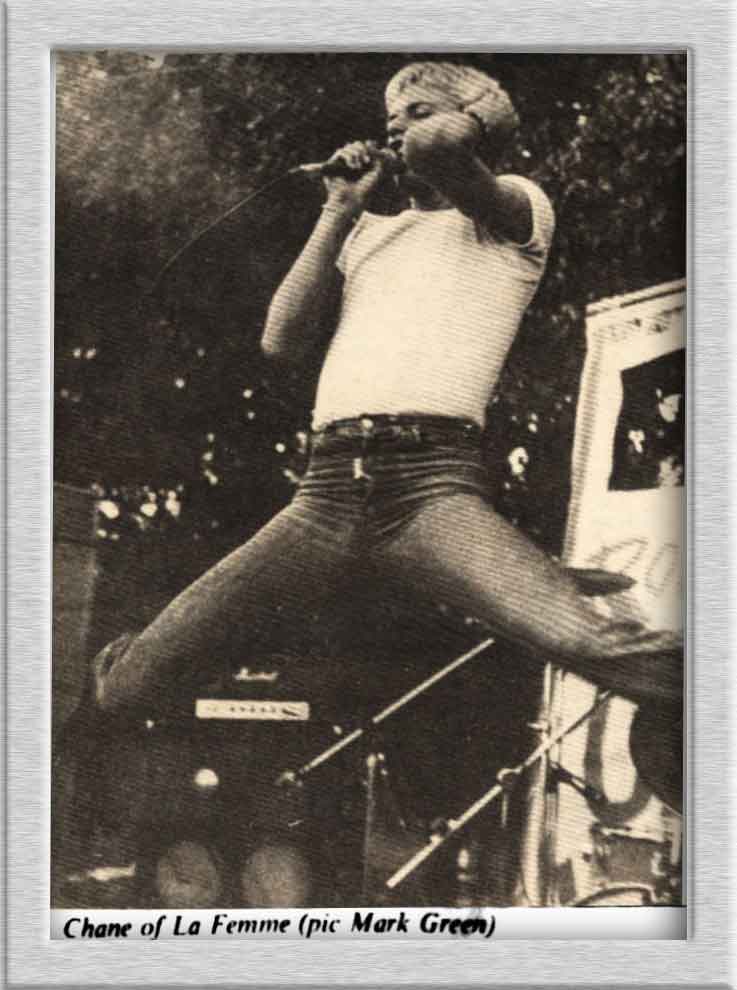
"Prior to the punk/new wave scene hitting Melbourne in 1978, I had only heard of Chane Bowie during my Sharpie days in the city by legend.
Perhaps the best memory was mid 1977 when some of the guys were winding up 'Carps' when he arrived at Flinders St Station one Saturday afternoon. Informing him that Chane Bowie and his boys are in town looking for him, Carps strutted pass us one by one with outreached hand saying, “10 cents”, “10 cents” ….as in to make a phone call for more backup. When we burst out laughing, he realised we were having him on and calling us all “shitmen”.
The first punk gig I ever went to was with Little Dave and Bash around late 1978 after picking up a flyer titled Lower Yourself. This was held at a small warehouse somewhere near the city and was the first time we saw The Models who were playing with support act Eric Gradman Man and Machine. The vibe on the night was electric and was the starting point with our music interest turning to the Melbourne new wave/punk scene.
A year earlier, I always remember Jacko was one of the first to get into punk and rocking up to the lockers at Flinders St Station to leave another album for the night that he bought from the import record shop in Collins St, Gaslight Records. Many were into the latest punk albums from the UK or USA such as Sham 69, New York Dolls, Buzzcocks, Generation X, Ramones, MC5, X-Ray-Spex and The Damned.
Not long after the 'Lower Yourself' gig, my friend Eric Simpson told us about a new local punk band called La Femme playing in Murrumbeena Rd at a Scout Hall. He said they were all ex-sharps and the lead singer was the legendary Chane Bowie I had heard so much about but was now known as Chane Chane.
Eric, Gerald, Little Dave and myself rolled up and although the crowd was small as expected with a band just starting out, it wouldn’t be long before they were packing the new punk live venues popping up around Melbourne. La Femme came at the right time with this new genre of music of the late 70’s and early 80’s and were one of our favourite live bands at the time." (Stef Egan)
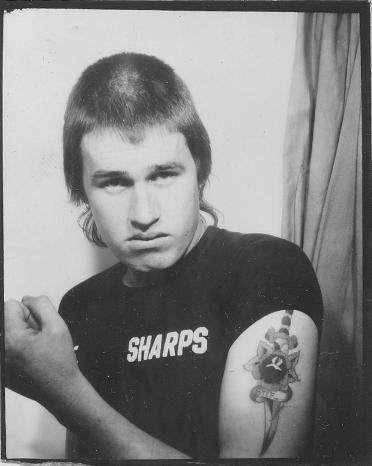
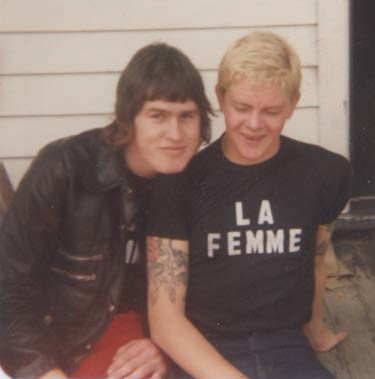

|
First Blood The 1960s Origins of the Australian Sharpie Youth Culture.pdf Size : 656.902 Kb Type : pdf |

|
Lobby Loyde - The G.O.D father of Australian rock.pdf Size : 3345.545 Kb Type : pdf |

|
So Sharp you could bleed - Sharpies and artistic representation, a moment in the seventies history of Melbourne.pdf Size : 235.615 Kb Type : pdf |

|
Tricks with mirrors - Sharpies and their representations.pdf Size : 218.418 Kb Type : pdf |
- Main Image - Sharpie graffiti - Source: Julie Mac
- Background Image - Sharpie media - Source: Subbaculture
- Sharpie couple, mid 1960s - Source: Top Fellas
- Oakleigh Sharps, 1966 - Source: Rodney Austin
- Pinstriped Baggies and checked Flags - Source: SNAP
- Rod, 1966 - Source: SNAP
- Chisel-toed shoes, c.1966 - Source: Required
- Max Merritt and the Meteors play at Catcher, c.1967 - Source: Facebook
- The Camberwell Junction Boys, 1970 - Photo by Graeme Penton
- Sharpies 1972 - Source: Top Fellas
- Peewee, Thomastown Sharps 1978/79 - Photo by John Bowie
- Sharpie girls 1976, cardigans and wedges - Source: Don Burgess
- Sharpie girls 1978 - Source: Julie Mac
- Sharpie fashion, 1960s and '70s - Source: SHARPIE Expo 2010
- Sharpie getting tattooed 1978 - Source: Brett Stewart
- Oak Park Boot Boys, 1973 - Courtesy Top Fellas
- Sharpies at Bananas, 1979 - Source: Required
- Sharpie girls turned punk, 1979 - Courtesy of Julie Mac
- Chane Chane, lead singer of La Femme, 1979 - Photo by Mark Green
- Stef Egan, 1977 - Source: Stef Egan
- Stef Egan and Eric Simpson, 1979 - Source: Stef Egan
- Short film by Carol Jerrems, 1973 - Source: Youtube
- Short film by Greg McCainsh, 1974 - Source: Youtube
- The Sharpies Dance Enhanced, 1975 - Courtesy of Brendan Young - Source: Youtube
- Deep by Rebecca McLean, 1998 - Courtesy of Rebecca McLean
- Stay Sharp - a short documentary exploring Melbourne’s iconic and often misunderstood Sharpie subculture of the 1970s, focusing on its resurgence in recent decades.
- Taylor, T. (2013). Top Fellas: Surefire Productions.
Mac, J. (2013). SNAP.
Beilharz, P. and Sian Supski (2015). Tricks with Mirrors: Sharpies and their Representations. Youth Cultures and Subcultures: Australian Perspectives, (Sarah Baker, Brady Robards and Bob Buttigieg (eds), Ashgate, Surrey).
Beilharz, P. and Sian Supski (2015). So Sharp You Could Bleed: Sharpies and Artistic Representation, A Moment in the Seventies History of Melbourne. pp.183–201.
Oldham, Paul. “Lobby Loyde: The G.O.D. Father of Australian Rock.” Thesis Eleven, vol. 109, no. 1, Apr. 2012, pp. 44–63.
Oldham, P. “Nazz” (2025) ‘“First blood”: The 1960s origins of the Australian Sharpie Youth Culture’, Journal of Australian Studies, pp. 1–15.
- Chris O'Halloran - Source: Skins'n'Sharps
- Cliff - Source: Top Fellas
- Julie Mac - Source: Julie Mac
- Tadhg Taylor - Source: Top Fellas
- Chane Chane - Source: Personal interview
- Stef Egan - Source: Stef Egan
- https://www.citysharps.com.au/
- http://forums.filmnoirbuff.com/viewtopic.php?pid=209755
- Crazee Kids Blogspot - Sharpies Attack CD, volume 1 & volume 2
- http://paperdoll-lingerie.blogspot.com.au/2012/01/larrikins-and-sharpiesa-bit-of.html
- http://www.sharpfilmproductions.com/
- http://sharpaustralia.blogspot.com.au/2009/09/skins-and-sharps-not-sharps_19.html
- http://themusic.com.au/news/all/2015/08/04/premiere-celebrate-70s-youth-subculture-with-when-sharpies-ruled-1438660328/
- http://dailyreview.com.au/when-sharpies-ruled-a-vicious-selection/29460
- http://sharpaustralia.blogspot.com.au/2009/09/skins-and-sharps-not-sharps_19.html
- https://www.smh.com.au/entertainment/when-sharpies-ruled-cd-celebrates-a-homegrown-sound-of-the-70s-20150801-gioitp.html
- http://www.vintag.es/2016/10/before-punks-there-were-sharpies-40.html
- https://www.discogs.com/release/7321520-Various-When-Sharpies-Ruled-A-Vicious-Selection
- https://www.abc.net.au/news/2015-08-31/sharpie-die-hards-use-music-to-keep-subculture-alive/6738658
- https://en.wikipedia.org/wiki/Sharpies_(Australian_subculture)
- https://en.wikipedia.org/wiki/Ten_Pound_Poms
- https://www.facebook.com/groups/830172477100721
- https://www.facebook.com/groups/1396994830524256
- https://www.facebook.com/groups/90431749249
- https://www.facebook.com/media/set/?set=oa.1398319983725074&type=1
